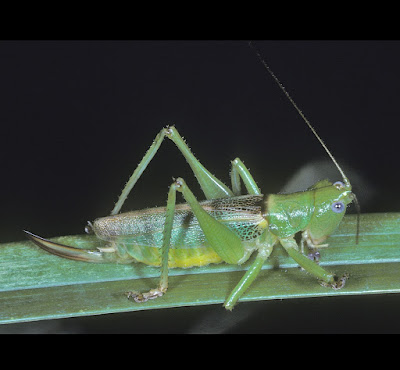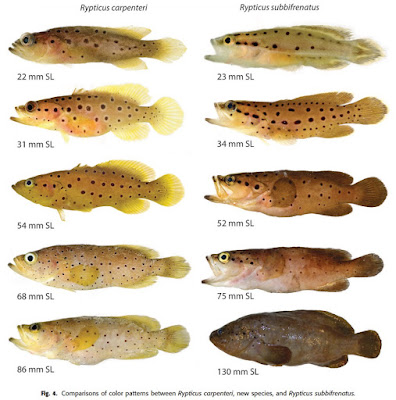[Most Recent Entries] [Calendar View]
Tuesday, July 5th, 2016
| Time | Event | ||||
| 2:41a | [Entomology • 2010] Studies in Australian Tettigoniidae: Australian Pseudophylline katydids (Pseudophyllinae; Phyllomimini), with Description of Four New Species of the Genus Acauloplacella from Queensland
Abstract The genus Acauloplacella Karny is recorded from Australia. Four new species are described, all in the subgenus Acauloplacella. The Australian representatives are related to those in New Guinea. All species occur in rainforest, especially along the margins. They are known from the east coast from disjunct populations from Iron Range south to near Townsville, Qld. They are nocturnal plant feeders with males uttering a stuttering call after dark. Key words: Tettigoniidae; Pseudophyllinae; Phyllomimini; Acauloplacella; taxonomy; biology Acauloplacella (A.) queenslandica Rentz, Su & Ueshima Chirping Leaf-mimic Acauloplacella (A.) hasenpuschae Rentz, Su & Ueshima Sue’s Leaf-mimic Acauloplacella (A.) incisa Rentz, Su & Ueshima Etched Leaf Mimic Named with reference to the median incision of the male tenth tergite. Acauloplacella (P.) mecyna Rentz, Su & Ueshima Iron Range Leaf Mimic Named with reference to the very elongate “stalk” of the male subgenital plate.
D. C. F. Rentz, You Ning Su and Norihiro Ueshima. 2010. Studies in Australian Tettigoniidae: Australian Pseudophylline katydids (Tettigoniidae; Pseudophyllinae; Phyllomimini). Zootaxa. 2566: 1–20. http://www.mapress.com/zootaxa/2010/f/zt | ||||
| 6:06a | [Entomology • 2016] Studies in Australian Tettigoniidae: A Review of the Australian Katydids of the Genus Goodangarkia (Conocephalinae; Agraeciini; Liarina)
Abstract Six species in Goodangarkia are described. Information on the distribution. ecology and cytology of species is presented. An unusual characteristic of cranial stridulation of one species is noted. Cytological evidence suggests the chromosome complement of species are more basal than those from Africa for example. Keywords: Orthoptera, Australian katydids, Conocephalinae, Agraeciini, ecology, behaviour, cytology D. C. F. Rentz, You Ning Su, Norihiro Ueshima and G.W. Wilson. 2016. Studies in Australian Tettigoniidae: A Review of the Australian Katydids of the Genus Goodangarkia (Tettigoniidae: Conocephalinae; Agraeciini; Liarina). Zootaxa. 4136(1); DOI: 10.11646/zootaxa.4136.1.3 | ||||
| 2:44p | [Ichthyology • 2012] Rypticus carpenteri • A New Species of Soapfish (Serranidae: Rypticus), with Redescription of R. subbifrenatus and Comments on the Use of DNA Barcoding in Systematic Studies
A new species of Rypticus is described from the Bahamas, Bermuda, Florida, and the Caribbean Sea. The species previously has been confused with the spotted soapfish, R. subbifrenatus Gill 1861, with which it shares a similar pattern of dark spotting on the body. The new species differs from R. subbifrenatus in having yellow pigment on the pectoral fin and distal portions of the soft dorsal, caudal, and anal fins in life (pale in preservative); a different configuration of dark spots on the head; usually dark spots on the belly and caudal fin; almost always four dorsal-fin spines; and modally 25 total dorsal-fin elements, 15 pectoral-fin rays, and 23 total caudal-fin rays. The lower jaw typically extends further anteriorly beyond the upper jaw in the new species than in R. subbifrenatus, and the caudal peduncle is usually narrower. The new Rypticus typically inhabits deeper waters than R. subbifrenatus, and is commonly found on vertical slopes and walls vs. shallow, flat areas. The new species likely would have continued to go unnoticed without examination of genetic data, as there was little reason to look further at R. subbifrenatus until DNA barcoding revealed two distinct genetic lineages within the species. The value of DNA barcoding data in systematic studies and the need for increased support of taxonomy are highlighted. A neotype for Rypticus subbifrenatus is designated. Rypticus carpenteri, new species Slope Soapfish Diagnosis.— A species of Rypticus distinguished from all congeners by the following unique combination of characters: pectoral fin and distal portions of soft dorsal, caudal, and anal fins pale yellow to yellow in life, pale in preservative; head and trunk with numerous dark spots, size of spots variable but those on head posterior to horizontal through center of orbit almost always smaller than pupil; interorbital region usually with two dark spots at posterior end, spots set slightly apart from orbital rim; belly with dark spots; caudal fin and sometimes soft dorsal and anal fins usually with at least a few, sometimes tiny, dark spots; dorsal-fin spines three or four (almost always four); total dorsal-fin elements modally 25; pectoral-fin rays modally 15; total caudal-fin rays modally 23; lower jaw extending anteriorly beyond upper jaw, mean difference between distance from tip of lower jaw to orbit and tip of upper jaw to orbit 5% head length (HL); caudal peduncle relatively narrow, average depth 11% SL. Distribution.— Bahamas, Belize, Bermuda, Colombia, Curacao, Dominica, Florida, Grand Cayman, Haiti, Navassa, Saba, Tobago, Turks and Caicos, and U.S. Virgin Islands–St. Croix (Fig. 6). Habitat.— Rypticus carpenteri inhabits clear tropical waters to depths of 40 m, but is found most commonly between 6 and 30 m (Fig. 7). Mean maximum depth of specimens examined herein is 17 m, and only six specimens were collected at depths ,5 m. Rypticus carpenteri lives among coral or rocks on steep slopes, vertical walls, or in other areas with large vertical relief, although a few specimens have been taken among coral heads in shallow flat areas. Etymology.— Named in honor of Michael Carpenter, station manager for the Smithsonian’s research station at Carrie Bow Cay, Belize, for more than 30 years. Mike’s dedication to maintaining this remote station benefited a multitude of marine scientists (and marine science). We thank him for his good-natured support in the field, and the first author is grateful for his enduring friendship. The common name, Slope Soapfish, is in reference to the occurrence of the species on steep slopes and other areas of vertical relief. Rypticus subbifrenatus Gill, 1861 Spotted Soapfish Rhypticus subbifrenatus Gill 1861:53 (type locality St. Thomas, U.S. Virgin Islands). Rhypticus nigromaculatus Steindachner 1867:42 (description; Barbados). Rypticus subbifrenatus Gill 1861.—Humann and DeLoach, 2002:189 (unnumbered color photo). Diagnosis.— A species of Rypticus distinguished from all congeners by the following unique combination of characters: pectoral fin and distal portions of soft dorsal, caudal, and anal fins tan to brown in life and in preservative; head and trunk with numerous dark spots; spots on head posterior to horizontal through center of orbit usually prominent, round or oblong, and one or more usually equal in size to or larger than diameter of pupil; posterior portion of interorbital region usually with two pairs of spots (sometimes joined as a stripe), spots directly on or abutting orbital rim; belly usually without spots; caudal fin usually without spots; dorsal-fin spines three or four (nearly bimodal); total dorsal-fin elements modally 26; pectoralfin rays modally 16; total caudal-fin rays modally 25; lower jaw extending anteriorly beyond upper jaw, mean difference between distance from tip of lower jaw to orbit and tip of upper jaw to orbit 4% HL; caudal peduncle relatively wide, average depth 13% SL. Distribution.— Antigua, Bahamas, Belize, Brazil, Colombia,Cuba, Curacao, Dominica, Dominican Republic, Equatorial Guinea, Fernando Poo, Florida, Grand Cayman, Grenadines, Haiti, Honduras, Jamaica, Mexico, Navassa, Nigeria, Panama,Puerto Rico, Tobago, Turks and Caicos, U.S. Virgin Islands, and Venezuela (Fig. 6). See ‘‘Remarks’’ for comments on identification of specimens from Brazil, Nigeria, and Fernando Poo. Habitat.— Rypticus subbifrenatus inhabits clear tropical waters to depths of 26 m, but it is found most commonly at 1–2 m (Fig. 7). Mean maximum depth of specimens examined herein is 5 m, and only six specimens were captured deeper than 15 m. Rypticus subbifrenatus lives in tide pools, among coral rubble, in patch reefs and shallow spur and groove reef areas, and occasionally it may be found on steep vertical walls. Baldwin, C.C. and Weigt, L.A. 2012. A New Species of Soapfish (Teleostei: Serranidae: Rypticus), with Redescription of R. subbifrenatus and Comments on the Use of DNA Barcoding in Systematic Studies. Copeia. 2012(1): 23-36. DOI: 10.1643/CG-11-035 | ||||
| 4:27p | [Botany • 2016] Begonia leipingensis • A New Compound-leaved Species (Sect. Coelocentrum, Begoniaceae) with Unique Petiolule Pattern from Guangxi of China Abstract Begonia leipingensis D. K. Tian, L. H. Yang & C. Li (2n = 30), a new species in Begonia sect. Coelocentrum from the limestone area of Guangxi, China. B. leipingensisis is easily distinguished from any other compound-leaved species in Begonia by its large variation in petiolule number and its unique spirally-arranged petiolule pattern, which has never been seen in Begoniaceae before and rarely seen even in other angiosperm taxa. Besides having non-overlapping flowering periods, it is clearly different from B. fangii, the most morphologically similar species in the same section and with the same chromosome number. In addition to its unique petiolule pattern, B. leipingensis has longer abaxial wings, shorter internodes, and usually larger leaves, leaflets and habit. Molecular phylogenetic analysis showed that B. leipingensis formed an independent lineage belonging to Sect. Coelocentrum. Morphological and phylogenetic evidence strongly supports this species as a new taxon in Sect. Coelocentrum of Begonia. B. leipingensis was assessed to be critically endangered based on criterion outlined by IUCN Red List Categories and Criteria. Keywords: China, Begonia, new species, morphology, endangered species, Eudicots Etymology:— This new species is named after the name of the town, Leiping, where it was discovered in Guangxi, southwest China. Distribution and Habitat.:— Only one population of this new species was discovered at Xinkang Village of Leiping Town, Daxin County, Guangxi, China (Fig. 7). The plants grow on moist rocks under the small trees and shrubs along shady pathsides on a limestone hill at 260–270 m elevation. Phenology:— Flowering August to October, fruiting September to December Chun Li, Li-Hua Yang, Dai-Ke Tian, Yue Chen, Rui-Juan Wu and Nai-Feng Fu. 2016. Begonia leipingensis (Begoniaceae), A New Compound-leaved Species with Unique Petiolule Pattern from Guangxi of China. Phytotaxa. 244(1); |
| << Previous Day |
2016/07/05 [Calendar] |
Next Day >> |







